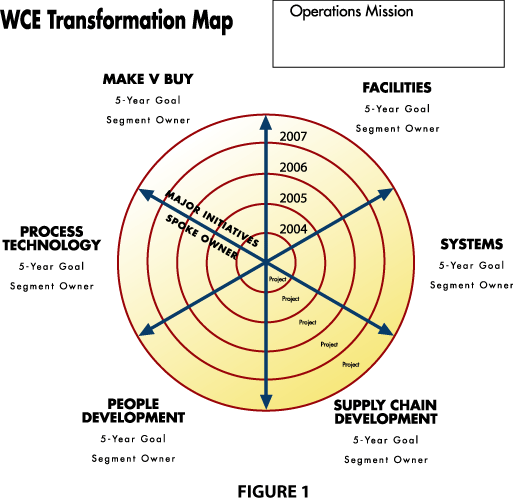 |
 |
|||
|
|
Home > About Us > News and Articles > "Kind'a, Sort'a" Lean . . . So What Comes Next? "KIND'A, SORT'A" LEAN . . . SO WHAT COMES NEXT?By David R. Dixon
These conditions suggest that we need to get better; and getting better requires that we choose and execute improvement projects that have maximum impacts on the performance and profitability of the business. A Trio of Techniques It is important to note our belief (based on years of observation) that companies become World Class performers one project at a time. Real improvement is the result of fundamental changes to our core business processes. These changes are rarely made “on the fly.” Carefully structured projects, properly resourced and meticulously executed, are the means by which we drive major change. Value Stream Mapping and analysis, as a means of selecting improvement projects, needs little explanation or defense. It is worth noting, however, that we often stop short of mapping the entire value stream (or all of the value streams). As we work to eliminate waste in administrative processes and in the supply chain, we will need to extend value stream mapping to include these activities. Too often, we also fail to iterate on the maps after we complete projects. As a result, we do not confirm the results and identify the next steps for improving the value stream. Value Stream Mapping, then, is an important tool for identifying improvement opportunities and should remain a mainstay in the project selection process. However, there are many business needs that are not revealed by a value stream map. Have we institutionalized the improvement process? Do our improvement efforts support directly the strategic needs of the business? Do we have issues and problems that are not addressed by the Lean tool kit? Where do Six Sigma tools apply? How do we measure our progress—can we demonstrate that we’re getting better? These and many other relevant questions are answered best by using a systematic assessment tool. These tools are commonly referred to as “Lean Maturity Models.” The version that we use at TCA goes beyond the application of Lean tools, however, and asks how well we are doing in each of five equally important areas:
Our model is used to quantify the status of the company’s progress in becoming a Lean/World Class Enterprise (WCE). Output from the assessment process provides another set of criteria
for selecting improvement projects. When combined with the knowledge
gained from Value Stream Mapping and analysis, we have a much more
comprehensive indicator of what needs to be done. In addition, the
quantified progress report provided by the Lean/WCE Maturity Model
can be a great motivator for people engaged in the improvement process.
As new levels of excellence are achieved, the company With the project alternatives suggested by the Value Stream Maps and the assessment process in hand, we suggest yet another innovative tool for governing the execution of these projects. The tool is called a WCE Transformation Map, or T-Map. A strategically focused, comprehensive WCE implementation program is a complex set of initiatives and projects with critical interdependencies. Many projects compete for the same resources, which forces us to make decisions about which projects to undertake in any given timeframe. The T-Map provides a means of visually analyzing the alternatives and documenting the plan once the decisions have been made. We then use the map to continuously check progress against the implementation plan. Figure 1 is a simplified illustration of the T-Map. More about its application will be found in this issue of Case-In-Point.
Leading the Charge Time has demonstrated that successful Lean/WCE implementations are buttressed with a strong leader and a surrounding cast of committed colleagues. But it goes further. Companies who are most effective form a Steering Team to direct the Lean/WCE implementation effort. This team devotes focused time and energy on the analysis of value stream maps, assessment results, and the strategic needs of the business. These inputs are used to develop and document the T-Map, which becomes a visual, directional signpost for the entire organization. The T-Map captures all of the activity necessary to improve current processes and to add new or expanded capabilities in support of the business strategy. Next, the Steering Team will position one or more Lean/WCE professionals to coordinate and support project teams and to act as a liaison between the project teams and the Steering Team. The Lean/WCE Coordination role has proven to be essential in a successful program. And finally, when all of the planning is in place and our coordinator in on board, we always face the dilemma of how to resource the initiatives and projects that we have chosen to work on. Because most people in the company are engaged pretty much full time with basic business functions, it is difficult to make them available for improvement projects. Creative ways of making people available and augmenting the permanent staff with temporary resources is perhaps the most important function that the Steering Team performs. The high powered planning generated and documented by the techniques described above, is useless unless we find crisp, effective ways of executing. Moving to the Next Level
The tools introduced here and discussed in more detail in this issue are designed to take performance to ever higher levels—to drive out the last vestiges of waste and variation in processes throughout the enterprise. We at TCA remain passionately committed to developing and sharing techniques, information and experience that help our clients in this quest. Call us any time with your questions. We love to talk about Lean and the World Class Enterprise.
Contact Us for a Free Assessment!
|
||
|
|
 After
a couple of decades of testing, Lean business practices are now
widely accepted as a major contributor to extraordinary customer
service and profitable operations. But with this acceptance has
come a new leveling of the playing field in many industries. The
preemptive competitive advantages enjoyed by early Lean adopters
have dissipated as more and more companies are “converted”
to techniques that reduce waste and slash lead times. We have also
come to the realization that only the most effective operations
can position a company to compete with competitors who source off
shore to suppliers in low cost labor markets.
After
a couple of decades of testing, Lean business practices are now
widely accepted as a major contributor to extraordinary customer
service and profitable operations. But with this acceptance has
come a new leveling of the playing field in many industries. The
preemptive competitive advantages enjoyed by early Lean adopters
have dissipated as more and more companies are “converted”
to techniques that reduce waste and slash lead times. We have also
come to the realization that only the most effective operations
can position a company to compete with competitors who source off
shore to suppliers in low cost labor markets.
 Dave Dixon is CEO of TCA.
Dave Dixon is CEO of TCA.